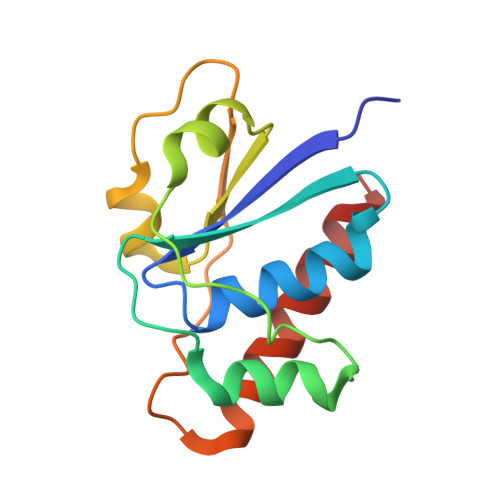The structure of a triple mutant of pI258 arsenate reductase from Staphylococcus aureus and its 5-thio-2-nitrobenzoic acid adduct.
Messens, J., Van Molle, I., Vanhaesebrouck, P., Van Belle, K., Wahni, K., Martins, J.C., Wyns, L., Loris, R.(2004) Acta Crystallogr D Biol Crystallogr 60: 1180-1184
- PubMed: 15159594
- DOI: https://doi.org/10.1107/S0907444904007334
- Primary Citation of Related Structures:
1RXE, 1RXI - PubMed Abstract:
Structural insights into formation of the complex between the ubiquitous thiol-disulfide oxidoreductase thioredoxin and its oxidized substrate are under-documented owing to its entropical instability. In vitro, it is possible via a reaction with 5,5'-dithiobis-(2-nitrobenzoic acid) to make a stable mixed-disulfide complex between thioredoxin from Staphylococcus aureus and one of its substrates, oxidized pI258 arsenate reductase (ArsC) from S. aureus. In the absence of the crystal structure of an ArsC-thioredoxin complex, the structures of two precursors of the complex, the ArsC triple mutant ArsC C10SC15AC82S and its 5-thio-2-nitrobenzoic acid (TNB) adduct, were determined. The ArsC triple mutant has a structure very similar to that of the reduced form of wild-type ArsC, with a folded redox helix and a buried catalytic Cys89. In the adduct form, the TNB molecule is buried in a hydrophobic pocket and the disulfide bridge between TNB and Cys89 is sterically inaccessible to thioredoxin. In order to form a mixed disulfide between ArsC and thioredoxin, a change in the orientation of the TNB-Cys89 disulfide in the structure is necessary.
Organizational Affiliation:
Laboratorium voor Ultrastructuur, Vlaams Interuniversitair Instituut voor Biotechnologie (VIB), Vrije Universiteit Brussel, Pleinlaan 2, B-1050 Brussel, Belgium. [email protected]

















